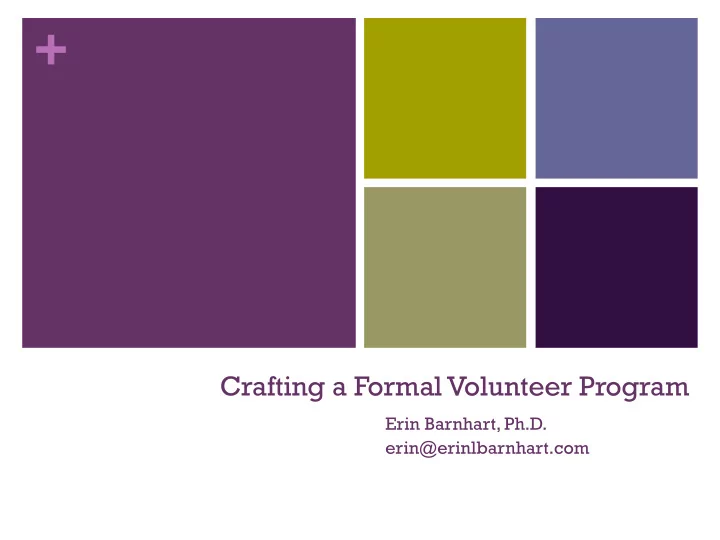

+ Crafting a Formal Volunteer Program Erin Barnhart, Ph.D. erin@erinlbarnhart.com
+ Overview n Foundational Elements of a Formal Volunteer Program n Resources for Next Steps n Questions?
+ Volunteer Program Vision n Craft a vision for your volunteer program: n Why do you want/need volunteers to partner with your organization? n What will successful volunteer engagement look like at your organization?
+ Volunteer Program Templates n Design volunteer program docs and templates: n Volunteer Application Form n Volunteer Contract / Agreement Form n Volunteer Handbook
+ Program Policies and Procedures n Determine and record the following: n Process for identifying, assessing, and avoiding risk n For each position: n What are the risks to the volunteer? What are the risks to the constituency? What are the risks to the organization? n Criteria for accepting or rejecting potential volunteers
+ Policies and Procedures cont. n Conflict resolution: n Disciplinary procedures n Process for letting volunteers go
+ Policies and Procedures cont. n Health and safety information n Procedures for emergency situations n Policies for managing and maintaining confidentiality n General organizational policies and expectations
+ Crafting Volunteer Positions n Brainstorm potential volunteer roles n Talk to staff! n Identify “wish list” items: n What can volunteers do? n What would staff rather do?
+ Crafting Volunteer Positions n Consider offering a mix of opportunities: n Long-term, short-term, episodic, advisory, online, etc. n Specific skill opportunities + flexible opportunities
+ Volunteer Position Descriptions n Craft a formal volunteer position description: n Title of the position n Brief description of the organization n Description of what the position is and why it matters n Key activities and responsibilities n Required and preferred qualifications n Time commitment and schedule n Where and when n Benefits to the volunteer n Contact details
+ Outreach & Recruitment n Consider your audience n Students, seniors, working parents, etc. n Consider your medium n Online, flyers, presentations, word of mouth, etc. n Consider your message n A tweet, a short humorous email, a long serious story, etc.
+ Outreach & Recruitment cont. n Make sure your organization is easy to find! n Can they figure out how to volunteer from your website?
+ Screening & Matching n Determine the appropriate level of screening n Vulnerable populations = background checks n Application, references, and/or interviews
+ Screening & Matching cont. n Determining an appropriate match: n Is the individual a good fit for your organization? n Does the volunteer have the necessary skills and experience needed to do the work? n Can you offer them a volunteer position that fits their needs, wants, expectations? n Will everyone be safe with this volunteer arrangement – the volunteer, the community, the organization?
+ Screening & Matching cont. n After assessing match, one of three actions: n Invite the volunteer to join your organization n Suggest other organizations or opportunities that might be a better fit n Thank them for applying but politely decline
+ Training & Orientation n Orientation = Introduction and context n What do they need to know to succeed? n How can you make them feel welcome? n Training = Nuts and bolts of the position n At the beginning + Ongoing
+ Communications & Supervision n Communications with volunteers n How will you stay in touch? n How will you keep them connected between volunteer shifts? n Supervision n How will you handle conflict situations? n More hands-on supervision needed at the start of a position and where safety is a concern n Schedule regular check-ins n Be available for questions, concerns, and ideas!
+ Recognition & Retention n Be sure to recognize your volunteers! n Ask how they prefer to be recognized n Make sure they know how they impacted the organization and its mission!
+ Recognition & Retention cont. n Keep your great volunteers! n Match skills and interests appropriately n Recognize and communicate regularly n Identify opportunities to move into new positions as desired
+ Tracking & Evaluation n Create a simple tracking process n Track volunteer contact details, hours, preferences, skills, etc. n Evaluate your program, your volunteers, and your role n Ongoing evaluation opportunities n Annual regular evaluation process
+ Resources for Next Steps n Energize, Inc. n https://www.energizeinc.com/a-z n Volunteer Canada n http://volunteer.ca/management n Volunteering England n http://www.volunteering.org.uk/ goodpractice
+ Questions?
Recommend
More recommend